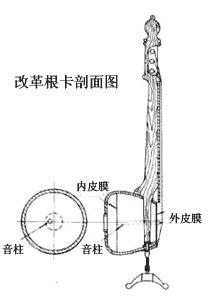Genka's History
Genka is a Tibetan bow and stringed musical instrument. It has a long history and originated from ancient Persia. It was only used for the accompaniment of classical singing and dancing "Nangma" at first, and was not popular in the folk. In the 1950s, it was reformed into a series of high, medium and bass cards. The timbre has a strong plateau flavor, and has been used for solo, ensemble, ensemble or as accompaniment to folk songs and dances.

According to ancient records, as early as 1300 years ago, Tibetan music developed to a higher level under the influence of Han culture, with perfect singing and dancing art. In the Tang Dynasty, the Tibetans were called "Tubo people". At that time, the two ethnic groups were closely related. In the fifteenth year of Tang Zhenguan (AD 641), Princess Wencheng, the daughter of Emperor Taizong's family, came to Lhasa and married the Tibetan leader Songtsen Gampo. , Emperor Li Shimin also specially sent a huge band to follow her into Tibet.
Some of the instruments left by the band are still preserved in the Jokhang Temple in Lhasa. Due to the dry climate in Tibet, the instruments have not been damaged much. These musical instruments are brightly colored and beautifully made. There are more than 50 pieces in total. It is said that this is only a part of them. There are also ancient Tibetan musical instruments, including Genka.
It has a long history. In addition to being treasured in the Jokhang Temple, only one root card is used in the band of the Dalai Lama Song and Dance Team of the Potala Palace in Lhasa. In the past history, it was not popular among Tibetan folk. .
The ancient root card has a unique and unique shape. It is very similar to the popular Aicek in Xinjiang Uyghur, and it is also similar to the Jichakqin in Uzbekistan, Turkmenistan, Tajikistan and other countries adjacent to our country, the South Caucasus and the Middle East. Similar to the kamanja, they are both the kamanja, a Persian stringed instrument that originated in the 10th century AD.
In the dark feudal society, Genka was appropriated by the upper-level rulers and only used to play the court classical music "Nangma" for the enjoyment of a few of them. Genka is also said to be used in the Dalai Lama's honor guard.
The Tibetan classical song and dance "Nangma" was developed on the basis of court classical music. At first, only one Jamunian was used to accompany it. In the late 6th Dalai Lama in the early 18th century, Genka was used as an accompaniment. In the 19th century, due to frequent wars and famines in Tibet, singing and dancing were depressed. Since the late 13th Dalai Lama in the early 20th century, the "Nangma" has declined again, and the Genka is on the verge of being lost. It was not until after the peaceful liberation of Tibet that Tibetan musicians got rid of the shackles of the Potala Palace and began to go to the people to show its exuberant youth.
 渝公网安备 50010702504639号
渝公网安备 50010702504639号